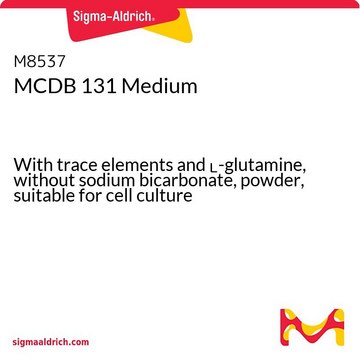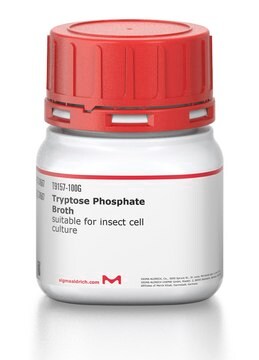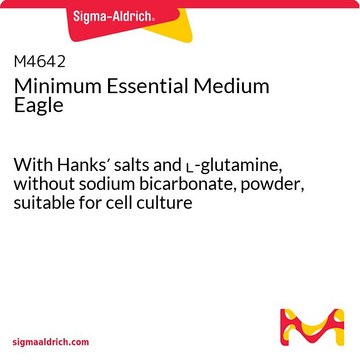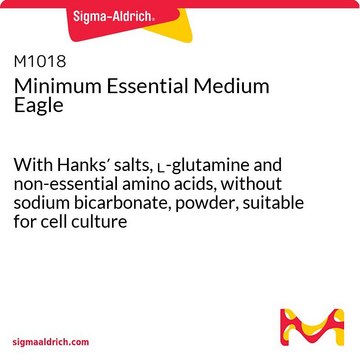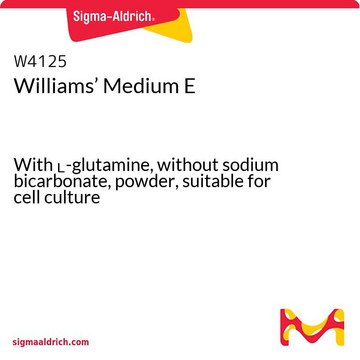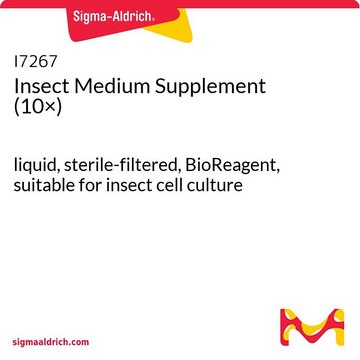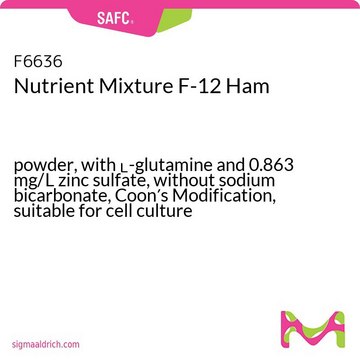L4386
L-15 Medium (Leibovitz)
With ʟ-glutamine and sodium pyruvate, powder, suitable for cell culture
Synonym(s):
Leibovitz L15
Sign Into View Organizational & Contract Pricing
All Photos(1)
About This Item
Recommended Products
Product Name
L-15 Medium (Leibovitz), With L-glutamine, powder, suitable for cell culture
Quality Level
form
powder
technique(s)
cell culture | mammalian: suitable
impurities
endotoxin, tested
components
sodium pyruvate: 0.55 g/L
phenol red: 0.011 g/L
L-glutamine: 0.3 g/L
shipped in
ambient
storage temp.
2-8°C
Looking for similar products? Visit Product Comparison Guide
General description
L-15 Medium (Leibovitz) is formulated for use in carbon dioxide (CO2) free systems requiring sodium bicarbonate supplements. It supports established cell lines, such as human larynx epidermoid cells (HEp-2) and Rhesus monkey kidney epithelial cells (LLC-MK2), as well as primary explants of embryonic and adult human tissue. L-15 medium can also be used for culturing viruses.
Application
L-15 Medium (Leibovitz) has been used:
- to study the toxicity of silver nanoparticles (AgNPs) with primary cultures of Eisenia fetida coelomocytes
- to culture crab hepatopancreas and ovary tissues
- as a component of the dissociation medium for infusion of the pancreas of mice
Quantity
Formulated to contain 13.8 grams of powder per liter of medium.
also commonly purchased with this product
Product No.
Description
Pricing
supplement
Product No.
Description
Pricing
Signal Word
Danger
Hazard Statements
Precautionary Statements
Hazard Classifications
Eye Dam. 1 - Skin Irrit. 2
Storage Class Code
11 - Combustible Solids
WGK
WGK 3
Flash Point(F)
Not applicable
Flash Point(C)
Not applicable
Choose from one of the most recent versions:
Already Own This Product?
Find documentation for the products that you have recently purchased in the Document Library.
Customers Also Viewed
Bernardo Saucedo et al.
Scientific reports, 9(1), 4453-4453 (2019-03-16)
Ranavirus is the second most common infectious cause of amphibian mortality. These viruses affect caudates, an order in which information regarding Ranavirus pathogenesis is scarce. In the Netherlands, two strains (CMTV-NL I and III) were suspected to possess distinct pathogenicity
Rajesh Guruswamy Damodaran et al.
Journal of tissue engineering and regenerative medicine, 12(5), 1230-1237 (2018-03-03)
Diabetes mellitus involves the loss of function and/or absolute numbers of insulin-producing β cells in pancreatic islets. Islet transplantation is currently being investigated as a potential cure, and advances in tissue engineering methods can be used to improve pancreatic islets
Y Qian et al.
Insect biochemistry and molecular biology, 27(5), 387-395 (1997-05-01)
Prostaglandins of the 2-series (e.g. PGE2) are typically synthesized from arachidonic acid (AA) after AA is released from cellular phospholipids after activation of an intracellular phospholipase A2 (PLA2). Treatment of isolated salivary glands with PLA2 inhibitor oleyloxyethyl phosphorylcholine (OPC) or
Steven J Conrad et al.
Avian diseases, 64(3), 243-246 (2020-11-19)
Marek's disease (MD) is an oncogenic, lymphoproliferative, and highly contagious disease of chickens. Its etiologic agent is the alphaherpesvirus Marek's disease virus (MDV, Gallid alphaherpesvirus 2), and it is a chronic and ubiquitous problem for the poultry industry with significant
Sarah Johann et al.
Toxics, 8(2) (2020-07-02)
Genotoxicity assessment is of high relevance for crude and refined petroleum products, since oil compounds are known to cause DNA damage with severe consequences for aquatic biota as demonstrated in long-term monitoring studies. This study aimed at the optimization and
Articles
L-15 Media Formulation
Our team of scientists has experience in all areas of research including Life Science, Material Science, Chemical Synthesis, Chromatography, Analytical and many others.
Contact Technical Service


